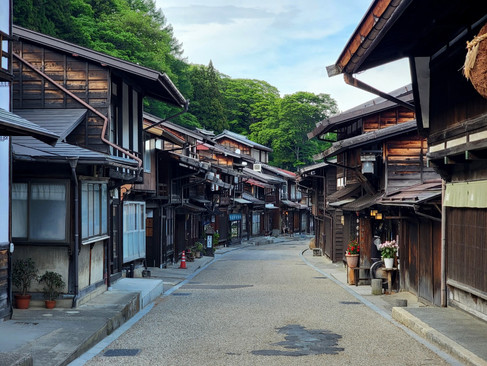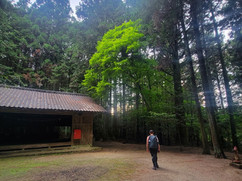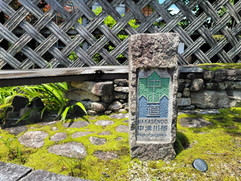This 5 day walking holiday is a section of the trail that runs through some of the most beautiful Edo architecture and forests of Japan's central mountains. Enjoy the pleasures of remote Ryokans, hidden shrines and delicious Kaiseki meals made with care and experience. This is the most paved and restroom friendly walking holiday we have yet to experience.

DINK Details
Well marked trail with a blend of towns, farms, forests, views and restrooms.
Deets: - Moderate hills, paved trails - Languages: Mostly Japanese / English | Getting There and Back: - Train from/to Tokyo 3.5 - 4 hours - Start at Mitake or Ena |
Plan Ahead: - Reserve hotels / dinner or a tour group (things book up fast)¹ - Bring a stamp book | Area Highlights: - Beautiful Edo era architecture - Mountains, rivers and rice fields |
1. We book places ourselves. Some places are booked up by tour groups or don't have a website
This is insane, how can a town look like this.
Why Nakasendō Way
After 4 years and a pandemic, the D.I.N.K couple was missing Japan. They also developed a taste for walking holidays. Three years of scenic videos of rural Japan on Tiktok can get to you. Researching details on postal towns like Magome and Narai made us pull the trigger.
The Nakasendō Way
This route in Japan was created in the Edo period to improve communications between Tokyo and Kyoto. To accomplish this, the many trails between 69 postal stations were connected and restored.
The result was The Nakasendō Way, the central mountain route.
This route is still maintained today, with most segments still easily walkable with several stops and lovely Ryokans.
Some guides recommend taking a train between stations to save time and enjoy more popular sections. Like the Camino walking holidays, this trail can be self guided or through a tour group.
Planning the Nakasendō Way (The Deets)
Our Walking Holiday
We went with the self guided approach and booked everything ourselves so we could pick our favorite places to stay. This also means carrying everything with you (Guide coming soon). Our booking process started 4 months in advance to prepare for our walk in end of May.
Our journey is detailed in this map and articles for each day here:
Starts in Mitake
Planning Yours
1. Pick a town to start
The start for us was the town Mitake since it had a train station (Ena was also an option). The make or break for the starting point was getting a res at the only hotel in Hiyoshicho, Daikokuya Ryokan (nothing else is near by).
2. Pick a place to end
While the end of our walking holiday was technically in Nojiri, the town of Narai is one of the most famous postal towns so we took a train there to sleep. Narai is recommended but guides also reference Kiso-Fukushima for ryokan and more walking. Nagiso is also a good stopping point with a train.
3. Booking Stays (and dinner)
A lot of places were booked up by tour companies so if you are doing a self guided walk, start looking early. If it is a ryokan in a postal town, book dinner (Kaiseki) well in advanced, there are towns where nothing else is open for dinner.
4. Packing
Bring a poncho and waterproof gear. We had a day with 24 hours of rain and it could have ruined the rest of the trip.
Pack a days worth of food and snacks incase. Some days had little to no rest stops so have something on hand.
Nakasendō Region
Hot takes
Very well maintained trails and paths
Public restrooms are everywhere (still can't believe how nice this was).
Not a lot of public drinking water (like the Camino) but a lot of vending machines.
Plenty of public transportation incase something were to interrupt the walk
The postal towns are mostly for tourism with locals living in-between these towns
Most places that aren't in the business of tourism, don't speak English. Learn some of the basics and bring your best body language.
So many shrines! They can be in some of the most beautiful places (extra stairs involved)
A lot of warning signs for bears and hornets (we saw none of these but ...... safety first)
Learn the name of the Nakasendō trail in Kanji: (中山道). Now you can read the sign.
Some days had large gaps of towns so bring extra water and food.
Many tourists shops are only open from 11-4. Great for mid day travel but not breakfast or dinner.
Sips and Bites
Kaiseki (of Nakasendō Way)
If you are staying at a Ryokan, make sure you reserve that Kaiseki ahead of time. A traditional Japanese meal with many dishes / courses all presented perfectly. The contents vary from region to region but usually have sashimi, grilled dish, simmer dish, rice and sake. The Nakasendō region commonly included mountain vegetables, river fish and koi (carp) dish. Don't forget the sake.
Note: The vibe of a Kaiseki is quite personal (similar to dining at a family member or friends home). Neas is not a fan of fish but had it, preferring not to disrupt the hospitality of the smaller Ryokans.
Yakiniku

Have you ever wanted to eat meat over a period of hours but hate when it gets cold? Yakiniku is the place for you! With a huge menu of meats (some vegetables) and a grill built into the table, feel free to order as much food and drink as you please.
Cook the Kobe beef for a few seconds or the beef tongue longer, this is a great way to heal after walking all day.
Konbini and Vending Machines
This is less about the the nature of the Konbini itself and more about their necessity on walking holidays. They are convenience stores which are located in more populated towns and they are better than any convenience store you know.
In the smaller areas, there is still a good chance of a vending machine appearing. These would always pop up where least expected and you can choose from hot (red) or cold (blue) beverages too! A hot boss coffee hits best from a vending machine next to a rice field.
Sake
The Sake scene is what craft beer wishes it was. Made all over Japan, from every corner. It is common to have a sake you will never see again. Every bottle is a new experience for us and the price is just unfairly low (I feel guilty). As you walk the trail, there will be tiny shops or distilleries to enjoy so take the time to rest and taste a taste you may never have again.
Stays
Ryokans
Always beautiful, charming and relaxing staying in Japan. A traditional sleeping setup which include a futon mattress on top of tatami mats. Most have well equipped bathing areas and provide traditional casual wear, the Yukata. There are some instructions on how to wear a Yukata properly, not my thing but Nea's and many others love the vibe.
There is also a tradition dinner (Kaiseki) served in room or dinning area, Daikokuya Ryokan was a perfect example of a Ryokan.

Book ahead of time. Some places don't have a reservation system and may require webform, email or even calling.
In many areas of Japan, these are remote and not in a town. This means booking your dinner at the ryokan and doing it ahead of time.
Maps
Our Nakasendo Map
Note: We started in Mitake and took a train after Nojiri






















































